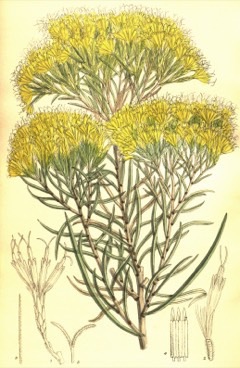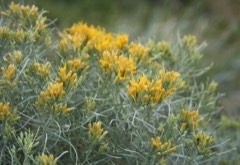 |
|
edibleplants.org |
 |
| Franz Xaver wikimedia.org |
Translate this page:
Summary
Physical Characteristics

 Ericameria nauseosa is an evergreen Shrub growing to 2 m (6ft) by 2 m (6ft) at a medium rate.
Ericameria nauseosa is an evergreen Shrub growing to 2 m (6ft) by 2 m (6ft) at a medium rate.
See above for USDA hardiness. It is hardy to UK zone 7. The flowers are pollinated by Insects.
It is noted for attracting wildlife.
Suitable for: light (sandy), medium (loamy) and heavy (clay) soils, prefers well-drained soil and can grow in heavy clay and nutritionally poor soils. Suitable pH: mildly acid, neutral and basic (mildly alkaline) soils and can grow in very alkaline soils.
It cannot grow in the shade. It prefers dry or moist soil and can tolerate drought.
UK Hardiness Map
US Hardiness Map
Synonyms
Bigelowia nauseosa M.E.Jones. Bigelowia nauseosa var. nauseosa. Chondrophora nauseosa (Pall. ex Pursh) Britton. Chrysocoma nauseosa Pall. ex Pursh. Chrysothamnus collinus Greene. Chrysothamnus concolor (A.Nelson) Rydb. Chrysothamnus frigidus var. concolor (Rydb.) A.Nelson. Chrysothamnus nauseosus var. frigidus (Greene) H.M.Hall. Chrysothamnus nauseosus var. macrophyllus J.T.Howell. Chrysothamnus nauseosus var. viridulus H.M.Hall. Chrysothamnus nauseosus subsp. viridulus (H.M.Hall) H.M.Hall & Clem. Chrysothamnus pallidus A.Nelson. Chrysothamnus plattensis (Greene) Greene. Chrysothamnus speciosus var. frigidus (Greene) S.F.Blake. Ericameria nauseosa subsp. nauseosa
Plant Habitats
Edible Uses
Edible Parts: Root
Edible Uses:
Edible Portion: Chewing gum, tea. A gum obtained from the root is used for chewing[46 , 61 , 95 , 257 ].
References More on Edible Uses
Medicinal Uses
Plants For A Future can not take any responsibility for any adverse effects from the use of plants. Always seek advice from a professional before using a plant medicinally.
A decoction of the twigs has been used in the treatment of toothaches, coughs and chest pains[257 ]. An infusion of the flowering stems has been used in the treatment of colds and TB[257 ]. An infusion of the leaves and stems has been used to treat colds, diarrhoea, stomach cramps etc[257 ]. It has also been used externally as a wash for sores and skin eruptions, especially smallpox[257 ]. The plant shows slight bactericidal activity[269 ]. In small doses, the extracts lowered the blood pressure briefly in rabbits. In large doses, the fall in blood pressure was pronounced, accompanied by circulatory and respiratory failure[269 ].
References More on Medicinal Uses
The Bookshop: Edible Plant Books
Our Latest books on Perennial Plants For Food Forests and Permaculture Gardens in paperback or digital formats.

Edible Tropical Plants
Food Forest Plants for Hotter Conditions: 250+ Plants For Tropical Food Forests & Permaculture Gardens.
More

Edible Temperate Plants
Plants for Your Food Forest: 500 Plants for Temperate Food Forests & Permaculture Gardens.
More

More Books
PFAF have eight books available in paperback and digital formats. Browse the shop for more information.
Shop Now
Other Uses
The plant is a source of latex, used in making rubber[46 , 61 , 95 ]. There is no commercially viable method of extracting it as yet[212 ]. This species has been identified as one of the more promising species from western N. America for the production of biocrude (hydrocarbon and hydrocarbon-like chemical fraction of plants which may be extracted by organic solvents and upgraded to liquid fuels and chemical feedstocks). Finding the cyclohexane extract to be 15.1%, the ethanol extract 20.8%, McLaughlin and Hoffmann (1982) calculated 13.2 kBTU/lb. in the extractables, a biomass yield of ca 4.5 MT/ha or 12.5 bbls, at a per barrel cost of $50.00 or $13.10/million BTU[269 ]. The leaves have been used as a sanitary towel, especially after childbirth[257 ]. A green dye is obtained from the bark[168 ]. A yellow-gold dye is obtained from the flowers[95 , 168 ]. The growing plant repels insects[99 ]. The cottony fruiting heads are used as a stuffing material for pillows etc[99 ]. Along with associated species, like big sage and western wheat grass, rubber rabbitbrush is a significant source of food for browsing wildlife on winter ranges. An ornamental xeriscaping shrub. Carbon Farming - Industrial Crop: hydrocarbon.
Special Uses
Carbon Farming
References More on Other Uses
Cultivation details
Experimental Crop Industrial Crop: Hydrocarbon Management: Coppice
This species thrives on poor soils and so is an indication that the land is poor, has been allowed to erode, has been overgrazed or in other ways neglected[212 ]. It is also reported to tolerate alkaline conditions, drought, heavy clays and poor soils[269 ]. The following notes are based on the general needs of the genus. Requires a sunny position and prefers a well-drained sandy soil[1 , 11 ]. Plants do not require a rich soil[11 ]. They tolerate alkaline soils[200 ]. The sub-species C. nauseosus ssp.. consimilis, is characteristic of sites with highly saline soils[269 ]. Climate: boreal to warm temperate. Humidity: semi-arid. Carbon Farming - Cultivation: experimental. Management: coppice.
Carbon Farming
-
Experimental Crop
Plant breeders are testing these plants to see if they could be domesticated for cultivation, but they are still in an experimental phase. Examples include milkweed and leafy spurge.
-
Industrial Crop: Hydrocarbon
Materials, chemicals and energy include bioplastics, rubber, biomass products gasoline, jet fuel, diesel, butane, propane, biogas. Plants are usually resprouting plants and saps.
-
Management: Coppice
Cut to the ground repeatedly - resprouting vigorously. Non-destructive management systems maintaining the soil organic carbon.
References Carbon Farming Information and Carbon Sequestration Information
Temperature Converter
Type a value in the Celsius field to convert the value to Fahrenheit:
Fahrenheit:
The PFAF Bookshop
Plants For A Future have a number of books available in paperback and digital form. Book titles include Edible Plants, Edible Perennials, Edible Trees,Edible Shrubs, Woodland Gardening, and Temperate Food Forest Plants. Our new book is Food Forest Plants For Hotter Conditions (Tropical and Sub-Tropical).
Shop Now
Plant Propagation
Seed - we have no information for this species but suggest sowing the seed in spring in a greenhouse and only just covering the seed. When they are large enough to handle, prick the seedlings out into individual pots and grow them on in a greenhouse for at least their first winter. Plant them out into their permanent positions in late spring or early summer, after the last expected frosts. Cuttings of half-ripe wood, mid summer in sand in a frame[200 ].
Other Names
If available other names are mentioned here
(formerly Chrysothamnus nauseosus), commonly known as Chamisa, rubber rabbitbrush, and gray rabbitbrush,
Native Range
NORTHERN AMERICA: Canada (Saskatchewan, Alberta, British Columbia), United States (Kansas (west), Nebraska (northwest), North Dakota, Oklahoma, South Dakota, Colorado, Idaho, Montana, Oregon, Washington, Wyoming, New Mexico, Texas, Arizona, California, Nevada, Utah), Mexico (Baja California (Norte))
Weed Potential
Right plant wrong place. We are currently updating this section.
Please note that a plant may be invasive in one area but may not in your area so it's worth checking.
None Known
Conservation Status
IUCN Red List of Threatened Plants Status : This taxon has not yet been assessed

Growth: S = slow M = medium F = fast. Soil: L = light (sandy) M = medium H = heavy (clay). pH: A = acid N = neutral B = basic (alkaline). Shade: F = full shade S = semi-shade N = no shade. Moisture: D = dry M = Moist We = wet Wa = water.
Now available:
Food Forest Plants for Mediterranean Conditions
350+ Perennial Plants For Mediterranean and Drier Food Forests and Permaculture Gardens.
[Paperback and eBook]
This is the third in Plants For A Future's series of plant guides for food forests tailored to
specific climate zones. Following volumes on temperate and tropical ecosystems, this book focuses
on species suited to Mediterranean conditions—regions with hot, dry summers and cool, wet winters,
often facing the added challenge of climate change.
Read More
Expert comment
Author
(Pallas ex Pursh) G. L. Nesom & Baird
Botanical References
Links / References
For a list of references used on this page please go here
A special thanks to Ken Fern for some of the information used on this page.
Readers comment
| Add a comment |
|
If you have important information about this plant that may help other users please add a comment or link below. Only comments or links that are felt to be directly relevant to a plant will be included. If you think a comment/link or information contained on this page is inaccurate or misleading we would welcome your feedback at [email protected]. If you have questions about a plant please use the Forum on this website as we do not have the resources to answer questions ourselves.
* Please note: the comments by website users are not necessarily those held by PFAF and may give misleading or inaccurate information.
To leave a comment please Register or login here All comments need to be approved so will not appear immediately.
|
Subject : Ericameria nauseosa
|
|
|
|